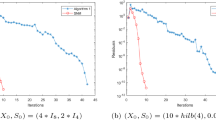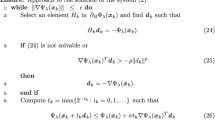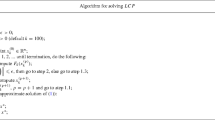Abstract
The paper presents a damped and perturbed Newton-type method for solving linear complementarity problems with positive-semidefinite matricesM. In particular, the following properties hold: all occurring subproblems are linear equations; each subproblem is uniquely solvable without any assumption; every accumulation point generated by the method solves the linear complementarity problem. The additional property ofM to be an R0-matrix is sufficient, but not necessary, for the boundedness of the iterates. Provided thatM is positive definite on a certain subspace, the method converges Q-quadratically.
Similar content being viewed by others
References
Fischer, A.,A Special Newton-Type Optimization Method, Optimization, Vol. 24, pp. 269–284, 1992.
Fischer, A., andSchönefeld, K.,Some Iterative Methods for Quadratic Programming, Technical Report No. 07-09-91, Department of Mathematics, Dresden University of Technology, 1991.
Fischer, A.,A Globally and Locally Q-Quadratically Convergent Newton-Type Method for Positive-Semidefinite Linear Complementarity Problems, Technical Report No. MATH-NM-04-1992, Department of Mathematics, Dresden University of Technology, 1992.
Mangasarian, O. L.,Equivalence of the Complementarity Problem to a System of Nonlinear Equations, SIAM Journal on Applied Mathematics, Vol. 31, pp. 89–92, 1976.
Wierzbicki, A. P.,Note on the Equivalence of Kuhn-Tucker Complementarity Conditions to an Equation, Journal of Optimization Theory and Applications, Vol. 37, pp. 401–405, 1982.
Aganagić, M.,Newton's Method for Linear Complementarity Problems, Mathematical Programming, Vol. 28, pp. 349–362, 1984.
Grippo, L., andLucidi, S.,A Differentiable Exact Penalty Function for Bound-Constrained Quadratic Programming, Optimization, Vol. 22, pp. 557–578, 1991.
Di Pillo, G., andGrippo, L.,An Exact Penalty Method with Global Convergence Properties for Nonlinear Programming Problems, Mathematical Programming, Vol. 36, pp. 1–18, 1986.
Kojima, M., andShindo, S.,Extension of Newton and Quasi-Newton Methods to Systems of PC 1-Equations, Journal of the Operations Research Society of Japan, Vol. 29, pp. 352–374, 1986.
Kummer, B.,Newton's Method for Nondifferentiable Functions, Mathematical Research, Advances in Mathematical Optimization, Edited by J. Guddat et al., Akademie Verlag, Berlin, Germany, pp. 114–125, 1988.
Kummer, B.,Newton's Method Based on Generalized Derivatives for Nonsmooth Functions: Convergence Analysis, Working Paper, Department of Mathematics, Humboldt University, Berlin, Germany, 1991.
Robinson, S. M.,Newton's Method for a Class of Nonsmooth Functions, Manuscript, Department of Industrial Engineering, University of Wisconsin, Madison, Wisconsin, 1988.
Ralph, D.,Global Convergence of Damped Newtons Method for Nonsmooth Equations via the Path Search, Technical Report No. TR 90-1181, Department of Computer Science, Cornell University, Ithaca, New York, 1990.
Pang, J. S.,Newton's Method for B-Differentiable Equations, Mathematics of Operations Research, Vol. 15, pp. 311–341, 1990.
Harker, P. T., andPang, J. S.,A Damped Newton Method for the Linear Complementarity Problem, Computational Solution of Nonlinear Systems of Equations, Lectures in Applied Mathematics, Edited by G. Allgower and K. Georg, American Mathematical Society, Providence, Rhode Island, Vol. 26, pp. 265–284, 1990.
Pang, J. S.,A B-Differentiable Equation-Based, Globally and Locally Quadratically Convergent Algorithm for Nonlinear Programs, Complementarity, and Variational Inequality Problems, Mathematical Programming, Vol. 51, pp. 101–131, 1991.
Burmeister, W., Private Communication, Dresden, Germany, 1985.
Clarke, F. H.,Optimization and Nonsmooth Analysis, Wiley, New York, New York, 1983.
Pšeničnyj, B. N., andDanilin, Ju. M.,Numerische Methoden für Extremalaufgaben, Deutscher Verlag der Wissenschaften, Berlin, Germany, 1982.
Schwetlick, H.,Numerische Lösung Nichtlinearer Gleichungen, Deutscher Verlag der Wissenschaften, Berlin, Germany, 1979.
Mangasarian, O. L.,Locally Unique Solutions of Quadratic Programs, Linear, and Nonlinear Complementarity Problems, Mathematical Programming., Vol. 19, pp. 200–212, 1980.
Cottle, R. W., Pang, J. S., andStone, R. E.,The Linear Complementarity Problem, Academic Press, San Diego, California, 1992.
Watson, L. T.,Solving the Nonlinear Complementarity Problem by a Homotopy Method, SIAM Journal on Control and Optimization, Vol. 17 pp. 36–46, 1979.
Pang, J. S.,Solution Differentiability and Continuation of Newton's Method for Variational Inequality Problems over Polyhedral Sets, Journal of Optimization Theory and Applications, Vol. 66, pp. 121–135, 1990.
Kojima, M., Mizuno, S., andNoma, T.,A New Continuation Method for Complementarity Problems with Uniform P-Functions, Mathematical Programming, Vol. 43, pp. 107–114, 1989.
Robinson, S. M.,Generalized Equations and Their Solution, Part 1: Basic Theory, Mathematical Programming Studies, Vol. 10, pp. 128–141, 1979.
Leder, D.,Automatische Schrittweitensteuerung bei global konvergenten Einbettungsmethoden, Zeitschrift für Angewandte Mathematik und Mechanik, Vol. 54, pp. 319–324, 1974.
Burmeister, W., Hess, W., andSchmidt, J. W.,Convex Spline Interpolants with Minimal Curvature, Computing, Vol. 35, pp. 219–229, 1985.
Schmidt, J. W., andHess, W.,Schwach verkoppelte Ungleichungssysteme und konvexe Spline-Interpolation, Elemente der Mathematik, Vol. 39, pp. 85–95, 1984.
Murty, K. G.,Linear Complementarity, Linear and Nonlinear Programming, Heldermann Verlag, Berlin, Germany, 1988.
Grippo, L., Lampariello, F., andLucidi, S.,A Nonmonotone Line Search Technique for Newton's Method, SIAM Journal on Numerical Analysis, Vol. 23, pp. 707–716, 1986.
Harker, P. T., andXiao, B.,Newton's Method for the Nonlinear Complementarity Problem: A B-Differentiable Equation Approach, Mathematical Programming, Vol. 48, pp. 339–357, 1990.
Author information
Authors and Affiliations
Additional information
Communicated by G. Di Pillo
The author would like to thank the anonymous referees and Dr. K. Schönefeld for their valuable comments and suggestions. He is also grateful to Prof. Dr. J. W. Schmidt for his continuous interest in this study.
Rights and permissions
About this article
Cite this article
Fischer, A. A Newton-type method for positive-semidefinite linear complementarity problems. J Optim Theory Appl 86, 585–608 (1995). https://doi.org/10.1007/BF02192160
Issue Date:
DOI: https://doi.org/10.1007/BF02192160




